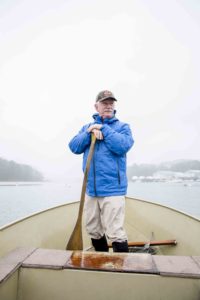The Legend of the Loaf
Tracing Sugarloaf’s past, from cutting trails through the backcountry to gondola rides up the mountain

I’ve always been envious of great skiers. They’re so powerful and graceful as they attack a slope—and so cool and sophisticated at après-ski.
Skiing wasn’t always so glamorous. It started as an adventure sport.
In Carrabassett Valley, skiing began at Bigelow, the big mountain to the north of Sugarloaf that dominates the views from the resort’s slopes. “You could drive to Bigelow,” says Chip Carey, a former marketing director at the Loaf. Before the 1950s, adventurers would turn off Route 27 at what we now call the Valley Crossing. At the base of Bigelow, they would put skins on their skis and start hiking up. Imagine what a day of skiing is like when you have to climb every vertical foot you ski down!
Skiing on Bigelow all but ended with Central Maine Power Company’s construction of the Long Falls Dam in 1950, which flooded a few towns to create a larger Flagstaff Lake. At first, residents of the towns thought building the dam was a great idea. They were all going to move to Skowhegan and get jobs at the mill. By 1950, as their homes were about to become “The Town that Drowned,” residents weren’t so sure, but it was too late.
Dude Wing once took me for a tour of the lake. We passed over the site of his boyhood home, which, like most of the rest of the town, had been disassembled before people left. He told me a neighbor vowed not to leave. Dude chortled, remembering that his father had said, “Okay, I’ll slow down when I go by in my motorboat, so I don’t knock bricks off your chimney.” The flooding above the dam also took out the road to Bigelow. With access to the 4,145-foot mountain blocked, skiers looked over to 4,237-foot Sugarloaf.
Reaching that vertical terrain took a lot of effort by people like Amos Winter. He was among the hearty ski-club people who began cutting the first trails and skiing the mountain. Access to Sugarloaf was the problem. Early skiers had to hike or skin in two miles from Route 27 along what we now think of as the Access Road. They then went straight up what is now Narrow Gauge trail. I can’t visit Sugarloaf without thinking of what our forefathers and foremothers did in the name of fun.
Over the years, the road was built. The social activity at Sugarloaf evolved nine miles away at the Valley Crossing. There was a legendary bar there called the Red Stallion. A good meal could be had at Tufulios. One of the original owners, Jack Flanagan, said he and the owner chose the name because they were told they were foolish to build an Italian restaurant there: “two-fool-ios!”
Sugarloaf has always attracted great people. They love good laughs, fun people, and most important, great skiing. “It has such a strong tribe of brand loyalists, people who make great sacrifices to get there every weekend,” says Nancy Marshall of Marshall Communications. “It’s part of their DNA. It gets under your skin.”
Various owners slowly developed Sugarloaf. One of the greatest additions was the gondola lift, which was built in 1965 and taken down in the 1990s. It carried people up 2,410 vertical feet in an 8,430-foot-long trip that was very, very slow. Former Sugarloaf general manager John Christie used to say that the gondola didn’t take very many people up Sugarloaf, but it brought a lot of people to Sugarloaf. It also gave Maine some European flair—as did the 1971 World Cup ski races. As part of the World Cup, the Arlberg-Kandahar race was also held at Sugarloaf when a snow drought in Europe forced organizers to move the race to Carrabassett Valley. Future Olympian Karl Anderson of Greene was one of the top competitors at the event. Having skiers like Austrian star Karl Schranz schussing down Sugarloaf added to its prominence.
Today, Sugarloaf is much more refined than it was way back then. However, just as the sport is built on the foundation of history, so too is Sugarloaf. You can see it at Sugarloaf gatherings all winter long, where everyone in the room is interesting. They are people who share several things, and the biggest among them is a love of place and great skiing.

